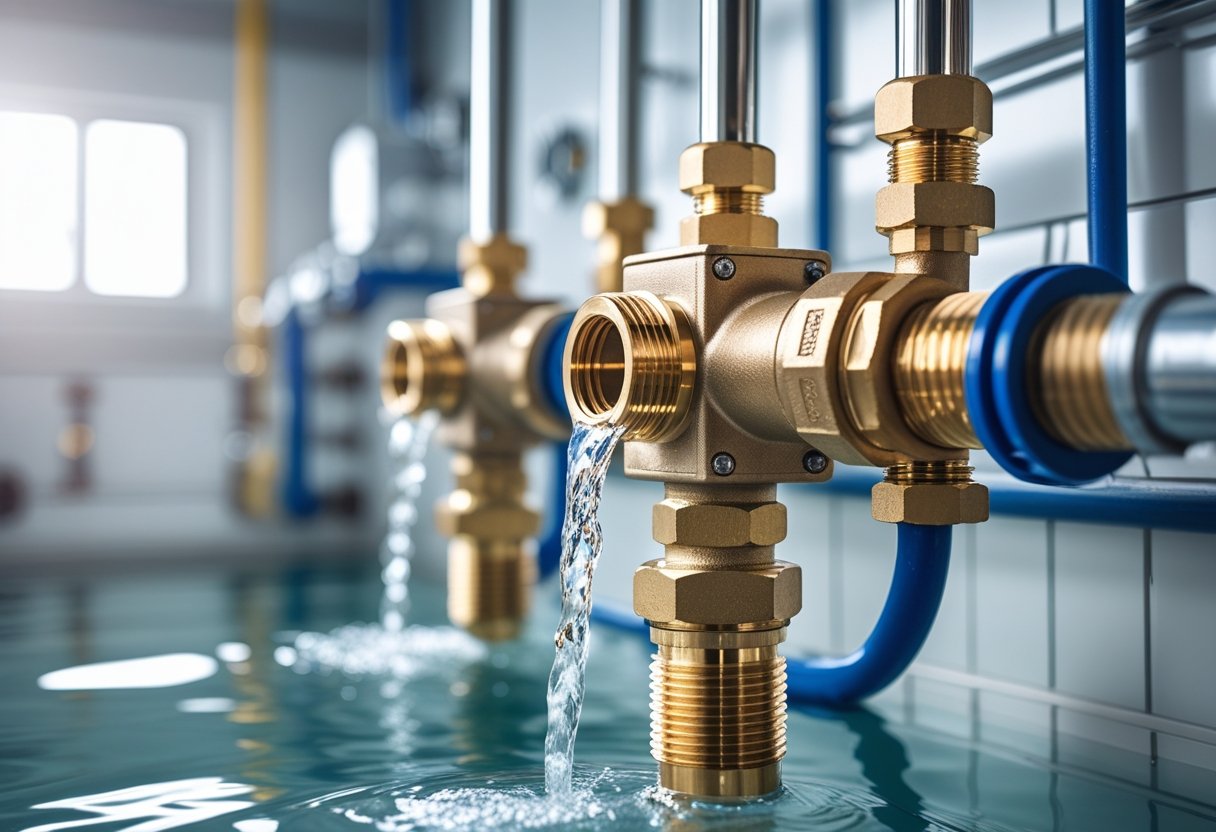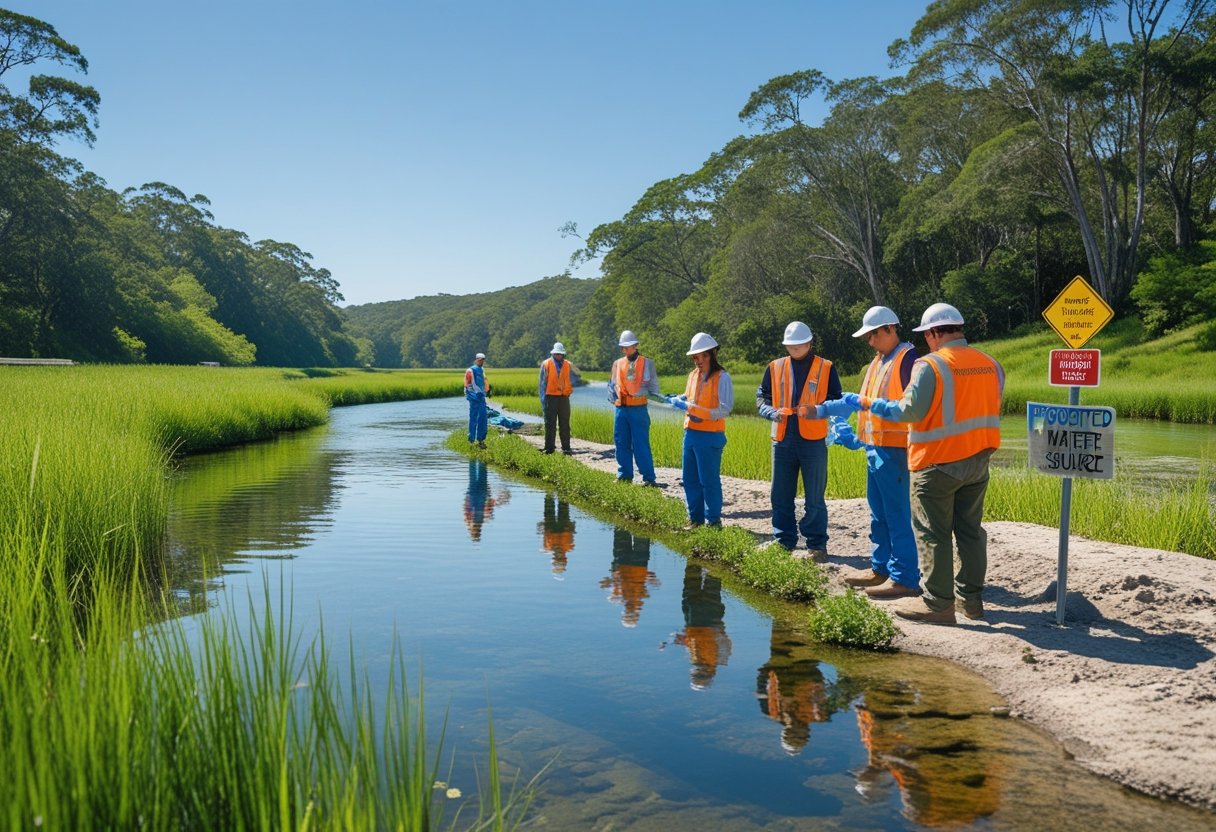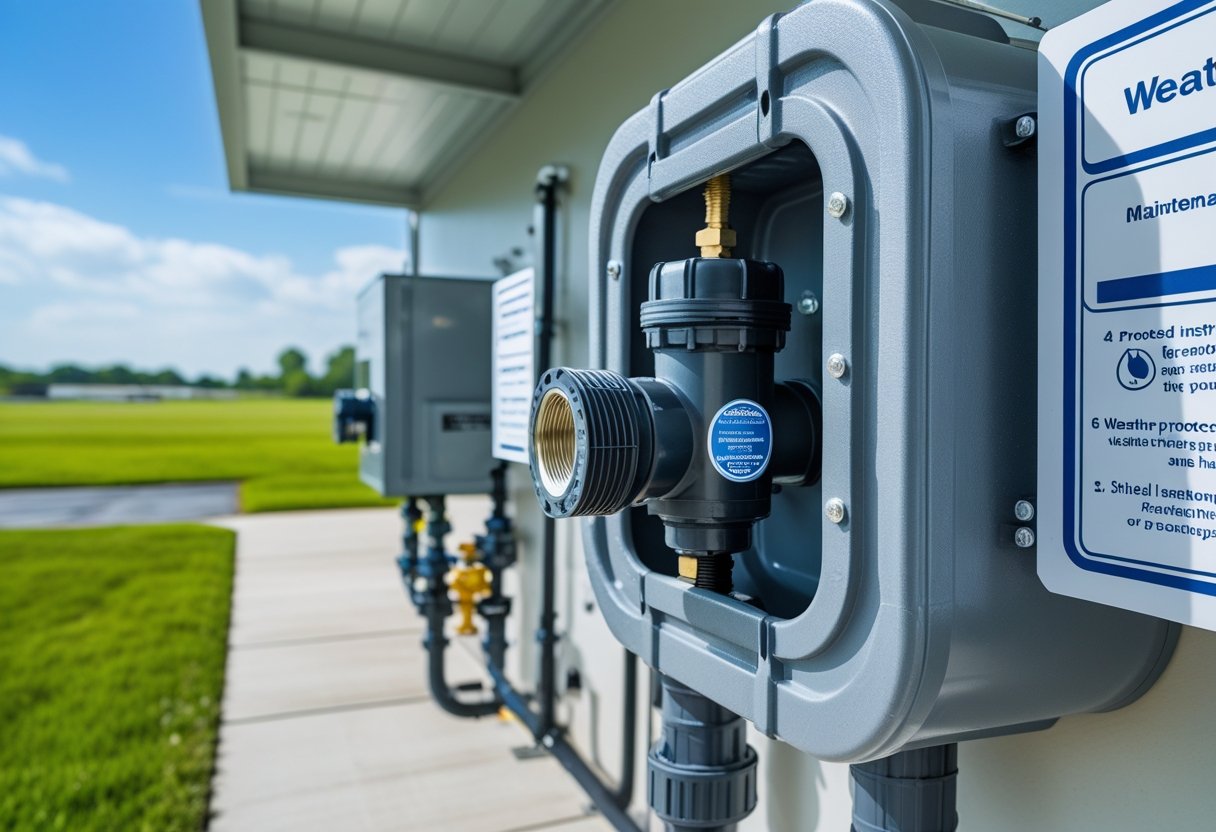Getting certified in backflow prevention is an important step if you want to work in plumbing or protect your community’s water supply. To get certified, you need to complete a state-approved training program and pass both a written and practical exam.
This ensures you have the skills to test, install, and maintain backflow devices that keep water safe and clean. The process may seem complicated, but it’s straightforward once you know the steps.
Many areas require annual backflow testing and certification to follow local rules. Becoming certified can open new job opportunities and help you stand out.
Understanding Backflow Prevention Certification
Getting certified in backflow prevention means you’ll learn how to protect water supplies by testing and maintaining devices that stop water contamination. You’ll need to know what backflow is, why certification matters, and the key responsibilities that come with being certified.
What Is Backflow Prevention
Backflow happens when water flows backward in a plumbing system. This can cause dirty or polluted water to enter clean water supplies.
Devices called backflow preventers stop this from happening. These devices must be tested and maintained regularly to work correctly.
You’ll learn how these devices function and how to spot issues like leaks or pressure changes during your certification training. This knowledge helps keep drinking water safe for everyone.
Importance of Certification
Certification shows you’re skilled and qualified to handle backflow prevention devices. Many states, including California, require you to complete approved training and pass exams before you can work legally.
Being certified allows you to test, repair, and install backflow preventers. Annual certification renewal or continuing education may also be needed to stay up to date with laws and technology.
This keeps you compliant and trusted by clients and water authorities.
Key Roles and Responsibilities
As a certified tester, you inspect devices to make sure they meet safety standards. You use special tools to check water pressure and device function.
If a device fails, you're responsible for recommending repairs or replacements. You also submit test reports to local water agencies to keep properties in compliance.
Your work prevents water contamination and supports public health. This makes your role very important in the community.
Eligibility Requirements for Certification
Before you start the certification process, you need to meet certain requirements. These include your education level, work experience, and following the rules set by your state or local area.
Meeting these is key to becoming a certified backflow prevention tester.
Educational Background Needed
You usually need at least a high school diploma or GED. Some states may require more education, but this is the common minimum.
Basic knowledge of plumbing, water systems, and safety standards helps you in training and exams. You don’t need a college degree, but taking courses related to plumbing or water quality can improve your skills.
Many training programs assume you have a basic understanding of plumbing concepts. If you are new to plumbing, it may be helpful to take introductory classes before applying.
Work Experience Prerequisites
Some certification programs require you to have hands-on experience with plumbing or backflow devices. This can include working as a plumber, technician, or in a related water system job.
Experience helps you learn how backflow preventers work and how to handle them safely. If you don't have prior experience, some training centers offer entry-level courses combined with practical training.
This prepares you to meet the work experience requirement by the time you take the certification exam.
State and Local Regulations
Certification rules vary by state and sometimes by city or county. For example, in San Diego County and California, you must complete a state-approved backflow training program.
Then, you need to pass a written and practical test. You must follow specific guidelines about who can test and maintain backflow devices.
Some places require annual recertification or refresher courses to keep your skills current. Make sure you know the regulations in your area before applying for certification.
Your future job will depend on meeting these local rules exactly as they are set.
Choosing the Right Backflow Prevention Certification Program
Finding the right certification program means you need to consider who runs it, how much it costs, and how you’ll complete the training. Each of these points can affect how well you learn and how soon you can start working as a certified backflow tester.
Accredited Organizations and Agencies
You want to pick a program approved by recognized organizations. In California, for example, the California-Nevada Section of the American Water Works Association (CA-NV AWWA) offers a solid certification.
Look for programs that meet state or local water authority rules. These programs will give you both the training and the exams you need to legally test and maintain backflow devices.
It also helps if the program includes both classroom lessons and hands-on practice. This way, you’ll get real experience with the equipment you’ll work on every day.
Cost and Program Length
Costs for backflow prevention certification vary. A program like CA-NV AWWA charges about $340.
Some programs may be less or more expensive depending on what they include. Also, check if any extra fees for study materials or retesting apply.
Programs usually take a few days to a couple of weeks. Shorter courses can be more intense, while longer ones spread out knowledge over time.
Make sure you have time to attend classes and review materials before exams. Some certifications need renewal, so factor those future costs and time requirements into your decision.
In-Person Versus Online Options
You can find both in-person and online backflow certification programs. In-person classes offer live help and hands-on training, which is useful for learning how to handle backflow devices correctly.
Online programs give you more flexibility. You can study at your own pace and fit lessons around your schedule.
However, many still require an in-person practical exam to prove your skills. Check if your state or local water agency accepts online training before signing up.
You want to be sure the program meets all certification rules and counts toward your license.
Application Process for Certification
You will need to collect certain documents, fill out an official form, and pay fees to apply for backflow prevention certification. Each step is important and helps make sure your application is complete and accepted.
Gathering Required Documents
Before you apply, gather all required documents. These may include:
- Proof of completed backflow training from an approved program
- Identification like a driver’s license or state ID
- Any previous certifications or licenses related to plumbing or backflow testing
- Payment receipts if you pre-paid for the exams or training
Having these ready will speed up your application. Check the specific requirements for your state or local water authority because rules can vary.
Completing the Application Form
You will need to fill out an official application form, usually provided online or by mail. Provide your personal details, contact information, and details about your completed training.
Be sure to:
- Use clear, correct information
- Attach copies of your training certificates and identification
- Follow all instructions carefully to avoid delays
Double-check the form before submitting to make sure nothing is missing.
Paying Application Fees
There is a fee to apply for certification. This covers the cost of processing your application and sometimes the exams.
Fees can vary but expect to pay around $300 to $350. You can usually pay by:
- Credit or debit card on the application website
- Check or money order mailed with your application
Keep your payment receipt for your records. Some programs may offer refunds if you do not pass the exam, but check the policies before you pay.
Preparing for the Backflow Prevention Certification Exam
To pass the backflow prevention certification exam, you need to focus on the right study materials, understand the exam format, and practice regularly. Knowing what to expect and using good resources will help you feel confident on test day.
Recommended Study Materials
Start by getting the official study guides approved by your state or local water authority. These guides cover key topics like plumbing codes, device types, and testing procedures.
Many state programs recommend materials from professional groups like the American Water Works Association (AWWA). You should also review local regulations since rules can vary.
Training programs often include manuals and hands-on practice to help. Use diagrams and flow charts to understand how backflow devices work.
Make sure to get detailed materials that include both theory and practical information. This will help you prepare for the written and hands-on parts of the exam.
Exam Format and Structure
The backflow certification exam usually has two parts: a written test and a practical test. The written exam checks your knowledge of backflow principles, regulations, and testing procedures.
It often has multiple-choice questions and may include some short answers. The practical exam tests your ability to inspect and test devices using real equipment.
You'll need to demonstrate skills like measuring water pressure or spotting leaks. The exam duration varies by state but generally lasts a few hours.
Know your testing location and bring required tools or materials if allowed. Arrive early and be prepared to follow all exam rules carefully.
Practice Tests and Study Tips
Taking practice tests can help you identify weak areas and get used to question styles. Many training programs offer sample tests or quizzes online.
Use these to time yourself and simulate the real exam environment. Create a study schedule to cover all topics in chunks.
Focus on one device type or regulation each day, then review previous sections regularly. Use flashcards for important terms and formulas.
Try to balance reading with hands-on practice. If possible, work with a certified tester or join a workshop to get real test experience.
Staying organized and practicing regularly will build your confidence for exam day.
Taking the Certification Exam
You will need to arrange your exam carefully, choose between testing options, and understand exactly what will happen on the test day. Preparing for these steps helps you complete the certification smoothly and confidently.
Scheduling the Exam
When you are ready to take the exam, register through an approved testing organization. Many programs allow you to schedule your test online or by phone.
Plan ahead because spots can fill up fast, especially in San Diego County where demand is high. You will be asked to choose a date that works for you.
Some programs have set testing dates, while others offer flexible options. Make sure you meet all prerequisites before scheduling.
Typically, you must complete a state-approved training program first. Also, check if there are any fees to pay, as many certification exams charge around $300 or more.
Onsite Versus Remote Testing
Backflow certification exams may be offered both onsite and remotely. Onsite testing is often held at a testing center or training facility.
This lets you use hands-on equipment and get immediate support if needed. Remote testing allows you to take the written part from your home or office.
You might use a computer with a webcam and special software to monitor the test. It is more convenient but requires a stable internet connection.
Hands-on practical exams usually must be done in person. Some programs split the exam into two parts: the written portion remotely and the practical onsite.
Confirm which options are available through your certification provider.
What to Expect on Exam Day
On exam day, arrive early if testing onsite. Bring any required IDs and your exam confirmation.
Also, bring any allowed materials, like pens or calculators, if specified. The exam usually includes a written test and a practical test.
The written test covers backflow prevention concepts, safety rules, and local regulations. You may see multiple-choice or short-answer questions.
The practical test requires you to demonstrate testing and troubleshooting of backflow devices using special tools. Your skills in identifying leaks or pressure issues will be evaluated.
Stay calm, read all questions carefully, and manage your time. After passing both parts, you will receive your certification, which allows you to legally test and maintain backflow preventers in San Diego and beyond.
After the Exam: Next Steps
Once you finish your backflow prevention exam, wait for your results and follow the steps to get your certification. If you don’t pass, you can try again.
Receiving Your Results
You usually get your exam results within a few days or weeks after completing both the written and practical parts. Some states send results by email, while others mail a paper notice.
Check the state water board or certifying organization website for exact timing. Make sure your contact information is current so you don’t miss the notification.
If you passed, you might receive a score report explaining your results. Some states require you to submit proof of training or test completion before you can get certified.
Certification Issuance Process
After you pass, the certifying body sends your official backflow prevention certification. This often takes a few more weeks after you receive your test results.
You may need to complete paperwork or pay a fee to get your card or certificate. Some states issue digital certificates or add your name to a public registry.
Note renewal dates and continuing education requirements to keep your certification up to date. Your certification lets you legally test, install, and maintain backflow devices in your area.
Always carry your proof of certification when working with clients or inspectors.
What If You Don’t Pass
If you don’t pass the exam, you can usually retake it. Review your score report to see which areas need improvement.
Many training programs let you retake the test after a waiting period, which is often 30 days. Use study guides, practice tests, or refresher courses to prepare.
If the practical part was difficult, practice the testing procedures with equipment before you try again. Some states limit the number of attempts within a set time, but you can keep retesting until you pass.
Maintaining and Renewing Your Backflow Prevention Certification
You need ongoing effort to keep your backflow prevention certification current. Meet education goals, pass renewal tests, and update your personal information to stay qualified.
Continuing Education Requirements
You must complete specific training to maintain your certification. Most states and programs require refresher courses every year or two.
These courses cover new rules, practical skills, and safety updates. Training often combines online lessons and hands-on practice.
Check with your certifying body for the required hours and approved course providers. Track your education credits regularly to avoid surprises at renewal time.
Recertification Process
To renew your certification, you usually need to pass a written exam and sometimes a practical test. These exams make sure you can still inspect and maintain backflow prevention systems.
Most renewal cycles occur every 2 to 3 years, but this can vary by state. Apply for renewal before your certification expires.
If you miss the deadline, you may need to retake the full training and exams. Schedule your renewal early to avoid interruptions or penalties.
Updating Personal Records
Keep your contact and employment information up to date with your certifying organization. This includes your mailing address, phone number, and place of work.
Accurate records ensure you receive renewal reminders, course announcements, and certification cards without delay. Some states require you to report changes within 30 days.
You can update your information online or by phone. Keeping your records current helps you avoid missed deadlines and keeps your certification valid.
Exploring Career Opportunities After Certification
Certification in backflow prevention opens up job options and career growth in the water safety field. You can find roles that match your skills and interests.
Building connections with other professionals helps you stay informed and find better opportunities.
Types of Jobs Available
Once certified, you can work as a Certified Backflow Tester. You will test, maintain, and repair backflow prevention devices to protect water supplies.
Many technicians work for plumbing companies, water districts, or specialized backflow service providers. Other roles include Backflow Prevention Technician and Backflow Assembly Installer.
These jobs involve installing and inspecting devices in homes, businesses, and public buildings. You can work full-time, part-time, or freelance.
Related fields like water quality inspection or municipal water management also value backflow knowledge. Certified testers are in demand, especially in areas with strict water safety regulations.
Advancing Your Career
You can grow your career by gaining more experience and earning additional certifications. Some advanced certifications let you work on complex systems or lead teams.
Taking courses in plumbing or water system maintenance can lead to promotions or higher pay. You might become a Backflow Prevention Supervisor or a technical trainer.
Joining professional organizations helps you stay current with rule changes and new technology. Employers value candidates who renew certifications on time.
Expanding your skills in related areas gives you more career options.
Professional Networking Tips
Building a strong network helps you find jobs and learn about industry trends. Join local or state backflow prevention groups.
Attend workshops and trade shows to meet other certified testers and plumbers. Online forums and social media groups offer ways to share advice and job leads.
Volunteer for community water safety projects to boost your connections. Keep your LinkedIn profile updated to highlight your certification and experience.
Staying active in these networks makes it easier to get referrals and special projects.
Frequently Asked Questions
Getting certified in backflow prevention means you must complete training, pass exams, and follow state rules. The time it takes and where you can learn depends on your area.
A career in backflow testing offers steady work protecting water systems.
What are the steps to become a certified backflow tester?
First, complete a state-approved training program. Then take both a written and practical exam.
Passing these exams gives you the certification needed to test and maintain backflow devices.
Where can I find backflow certification classes in my area?
You can find classes at local plumbing schools, community colleges, or specialized backflow training centers. Some water districts also offer or recommend approved courses.
Can I obtain a backflow prevention certification online?
Some theory parts of the courses are available online. You must attend practical tests in person to show your skills on actual devices.
What are the requirements for backflow certification in California?
In California, you need to complete approved training and pass both a written and hands-on practical test. You must also renew your certification regularly according to state guidelines.
How long does it take to complete a backflow certification program?
Programs usually take a few days to a couple of weeks, depending on the course format. Training covers both theory and hands-on practice for the exams.
Is pursuing a career in backflow testing a worthwhile investment?
Yes, if you want steady work in plumbing and public safety.
Certified testers are always needed to ensure clean water.
They maintain backflow preventers in homes and businesses.











